Pitching to the limits of artificial intelligence
UTSW teams use their brainpower to come up with innovative health care projects at inaugural AI Innovations Challenge
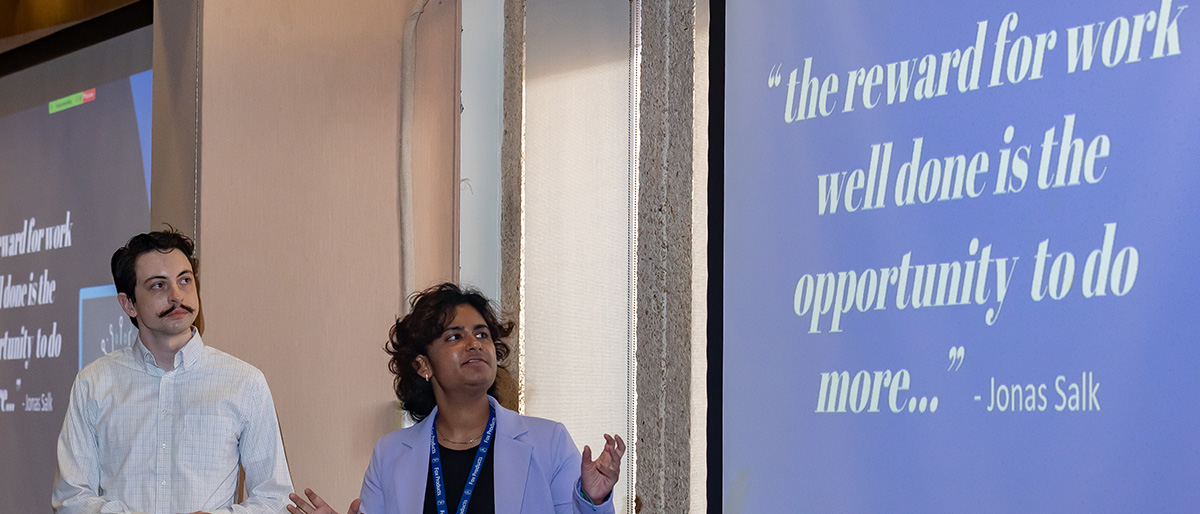
Over the summer, a UTSW team called Phixer started developing a product using artificial intelligence (AI) to reduce the documentation burden on physicians, enhance diagnostic precision, and improve patient outcomes.
Phixer’s efforts revealed the potential of AI technology to advance health care, winning first place in UT Southwestern’s inaugural AI Innovations Challenge, open to UTSW employees, learners, and trainees. The group used AI-powered conversation analysis and diagnostic support to summarize doctor-patient interactions and provide real-time insights. The team was among three to present innovative AI-based projects.
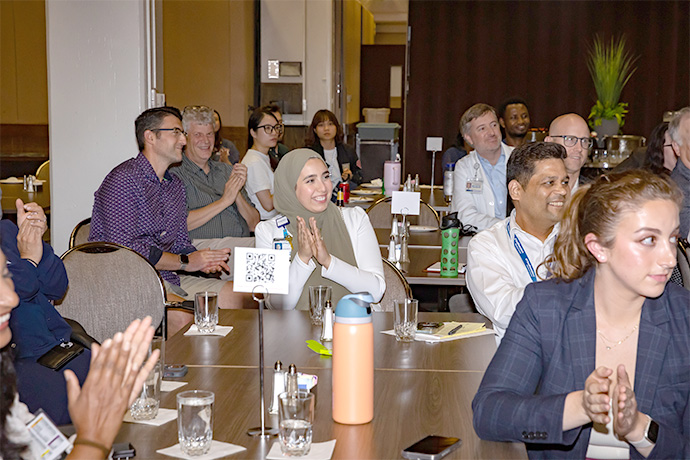
The goal of the challenge was to foster interdisciplinary collaboration among UTSW clinicians, researchers, students, trainees, and staff scientists to develop practical AI applications in life sciences, biotech, and health care.
Co-sponsored by the Office for Technology Development (OTD) and the Lyda Hill Department of Bioinformatics, the challenge was open to UTSW personnel. The event was more about collective learning and development than direct competition, organizers said.
“At UT Southwestern, there is an impetus to integrate cutting-edge technology into everyday health care as a leading academic medical center. Health care, research, and medical education would benefit tremendously with artificial intelligence integration,” said Prapti Mody, Ph.D., Program Manager in the Lyda Hill Department of Bioinformatics.
In June, three teams comprised of 12 total participants were selected for the program. From July 1 to Aug. 28, team members attended talks by mentors and partners working in the health care industry and educational institutions across the country to help them gain crucial commercialization skills through virtual and live lessons on financial literacy, legal and policy issues, regulatory affairs, funding, and other topics.
Simultaneously, they began designing and testing their AI projects with significant guidance from mentors at UTSW and industry partners. Among the mentors was Hayden Blackburn, former COO of TechFW, who provided two coaching sessions to each team to help them prepare their pitches. Eric Zimmerman, Principal Healthcare & Life Sciences Business Development, Venture Capital & Startups at Amazon Web Services, provided Amazon Web Services credits to help participants build their AI tools.
The challenge concluded Aug. 29 at the A.W. Harris Faculty Club when teams pitched their ideas to an audience that included industry partners and UTSW clinicians, academics, and staff. At each table, audience members cast votes for first, second, and third place winners. Proposals were judged on uniqueness, relevance to health care issues, and commercial viability.
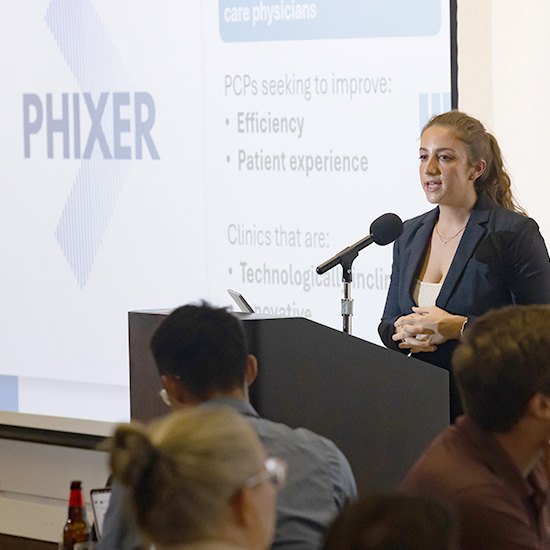
Since most Phixer team members are physical or occupational therapists with clinical backgrounds, they viewed the challenge as a novel, exciting, and invigorating learning experience, said Hari Vennelakanti, PT, D.P.T., team leader and a certified oncology lymphedema Physical Therapist.
“It wasn’t just about the result; it was about the collective effort, the shared commitment, and the belief that we could achieve something remarkable together,” Dr. Vennelakanti said. “We dove into the world of business and technology, thinking and creating like a startup. The competition provided us with the tools needed to succeed in blending AI into health care.”
UMed Imaging, which developed a model to minimize patient radiation exposure by converting medical images across multiple modalities, took second place. MedBox, which proposed an automated grading and feedback assistant for medical education programs and simulation centers, came in third.
Streamlining primary care
Phixer focused on developing a tool that eased the burden of documentation for clinicians and improved the quality of patient care. The team used machine learning (ML) technologies to transcribe doctor-patient conversations in real time, offer diagnostic support, and generate comprehensive visit summaries, said Nicole Wiggs, PT, D.P.T., a Phixer team leader, Physical Therapist, and Outpatient Therapy Manager.
“The overall goal was to reduce the administrative burden for providers and allow more time and space for human interaction,” Dr. Wiggs said. “Connecting, listening to, and helping patients are the reasons we all got into the medical field, and AI will be a great solution to enable this.”
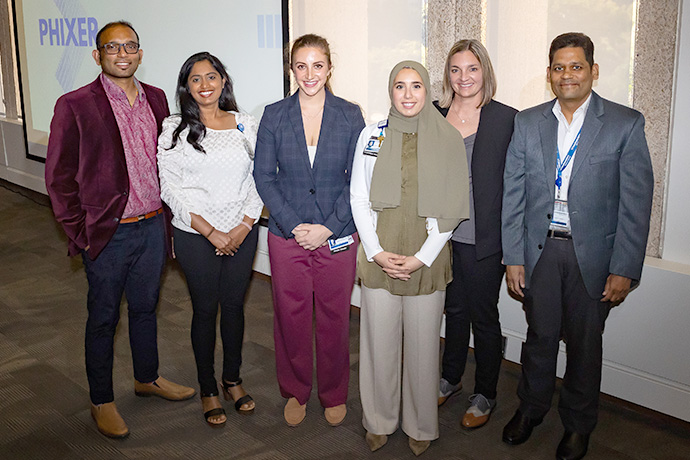
Since winning, Phixer has been busy refining its prototype and gathering feedback from primary care providers and other stakeholders.
“As we advance, we are excited about the potential of our product to revolutionize the way documentation is handled in health care settings,” Dr. Vennelakanti said. “We believe that with the right support and continued dedication, we can bring this innovative solution to market and make a meaningful difference in the health care industry.”
Decreasing radiation exposure
UMed Imaging developed a deep learning model capable of converting between multiple medical imaging modalities, such as CT, PET, and MRI scans.
“This innovation has the potential to streamline radiotherapy processes by reducing the need for multiple scans,” said Yunxiang Li, team leader and a student in the Biomedical Engineering Graduate Program. “It also lowers health care costs and minimizes radiation exposure.”
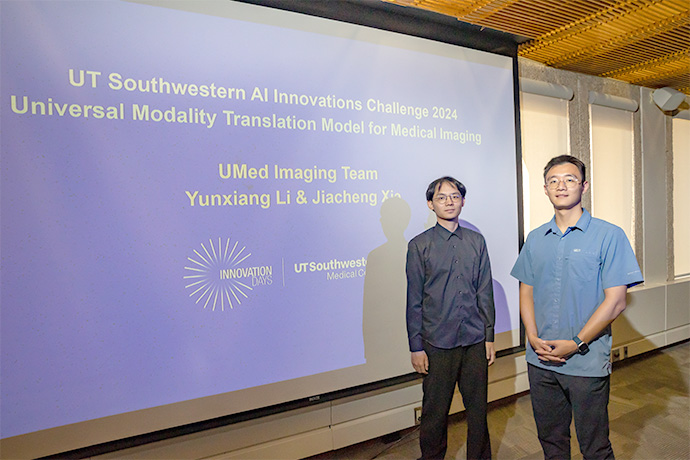
In radiotherapy, multiple imaging modalities are used to optimize treatment plans and evaluate therapeutic efficacy, Mr. Li said. The lack of an effective universal modality conversion model hinders the integration of these different methods, since it is usually technically, logistically, and financially challenging to acquire all of them for each patient.
“Our model will help reduce clinical burdens, decrease radiation doses, and lower medical and time costs, which in turn will optimize the entire radiotherapy process, providing patients with safer and more effective treatments,” he said.
Automating medical education
MedBox, the three-person team from the Jamieson Lab in the Lyda Hill Department of Bioinformatics, focused on using AI to automate grading and feedback for medical education programs used in the UTSW Simulation Center. The project was developed in collaboration with the Simulation Center.
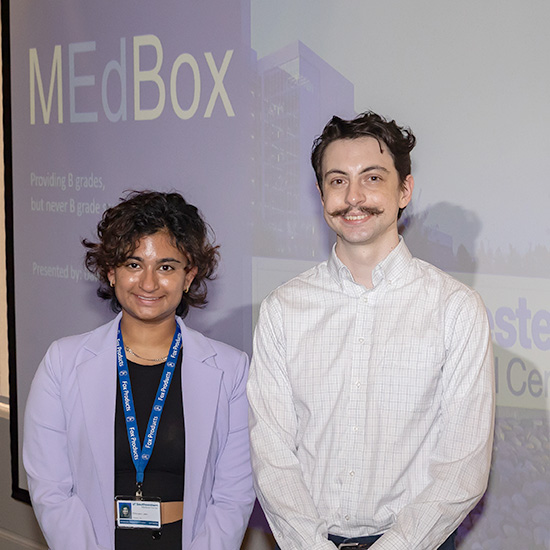
Typically, a medical student at the Sim Center performs a mock visit with a patient-actor and writes up an encounter note after the visit, said team leader David Hein, M.S., Data Scientist. These notes are then graded by hand.
MedBox includes an institutionally tailored custom hardware-software “box” of pre-curated pipelines deploying large language models. This strategy allows MedBox to handle time-consuming tasks.
One example is grading the videos of the medical student encounters with patient-actors.
“We have tools that create a transcript from the video recordings, then use that transcript as text input to a model to detect whether the students performed the correct physical exam,” Mr. Hein explained.
The patient-actor might have allergy symptoms, for example, and part of the student’s grade for that practice scenario is performing an ear exam. Automated grading focuses on the technical details and enables the patient-actors to prioritize assessing the student’s communication and interpersonal skills.
“This approach would improve health care by allowing medical students to do more practice patient encounters,” Mr. Hein said. “If the grading and feedback by AI systems can be more rapid, students could do a whole lot more patient encounters – and this would also free up instructors.”
These promising ideas are just a glimpse of what the future holds for possibilities with AI, explained Brad Phelan, M.B.A., Associate Vice President of Technology Commercialization and Business Development.
“A key facet of OTD’s mission is to advance UT Southwestern technologies toward the commercial market to positively impact patient lives, and the AI Innovations Challenge is a great example of programming that OTD supports to help us achieve that mission,” Mr. Phelan said.

